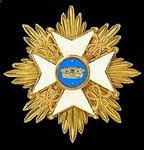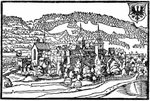Wednesday, 28 November 2007
Subscribe to:
Post Comments (Atom)

Being a uniform and flag design service to wargamers and to the imaginary crowned heads of 17th and 18th Century Europe, especially of the Seven Years War period - now By Appointment to the Court of Saxe-Bearstein! (But please note that the uniforms and flags presented here are not fictional - they are genuine 17th and 18th Century uniforms and flags that are as authentic as I can make them from my sources.)















Cool, then I need to get some minis to go with the templates!
ReplyDelete:-)
Cool indeed, but in my (very peculiar & heretic) opinion, Austrian jägers minis would look *so much better* if painted in the (already too glamorous to be 'historical'?) colors of the pattern recently posted at the Tippelbruder Uniforms Shoppe:
ReplyDeletehttp://freistadttippelbruder.blogspot.com/2007/11/future-of-templates-from-tippelbruder.html
BTW, David, will you solve for us the (pseudo?) mystery of the Austrian jägers, depicted (according to Funcken: I know, not the most reliable 4th hand source) by contemporary painters either in grey or in light blue?
Perhaps a blueish grey difficult to describe / reproduce accurately; &/or differential fading of divers pigments mixtures used by various colorists to give approximatively the same hue? A similar problem seems to exist (have existed?) with the coat of Napoleon's Train des Equipages, depicted in any shade from light neutral grey to bright light-medium blue!
Cheers,
Jean-Louis
Hi FB,
ReplyDeleteToo true! ;-) Thanks.
David.
Hi Jean-Louis,
ReplyDeleteAh, well, that one's a Prussian jäger who were altogether rather more attractively dressed than the Austrians, I'm afraid (IMHO). ;-)
The Austrian jägers wore a hechtgrau or pike grey uniform, not blue, according to everything I have (including Duffy and the book on the Albertina manuscript) so definitely much more grey than blue - although defining these colours exactly is not easy. Presumably at the time there was much variation in the field, given that the vegetable dyes mostly used were variable anyway and the fact that they would quickly fade and change in use. (Note, for instance, that the smallclothes of Prussian infantry units were dyed by the company so that at least within each company there would not be too much variation in colour.)
So yes, the Funckens are wrong on the Austrians, I'm afraid!
All the best,
David.